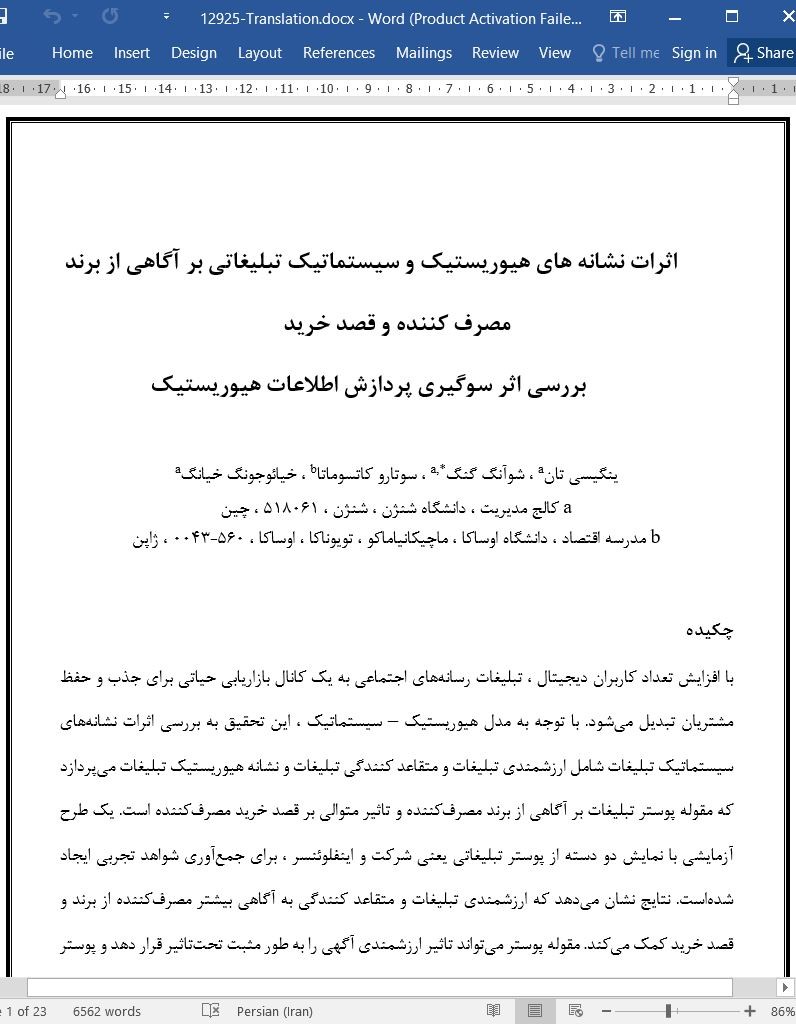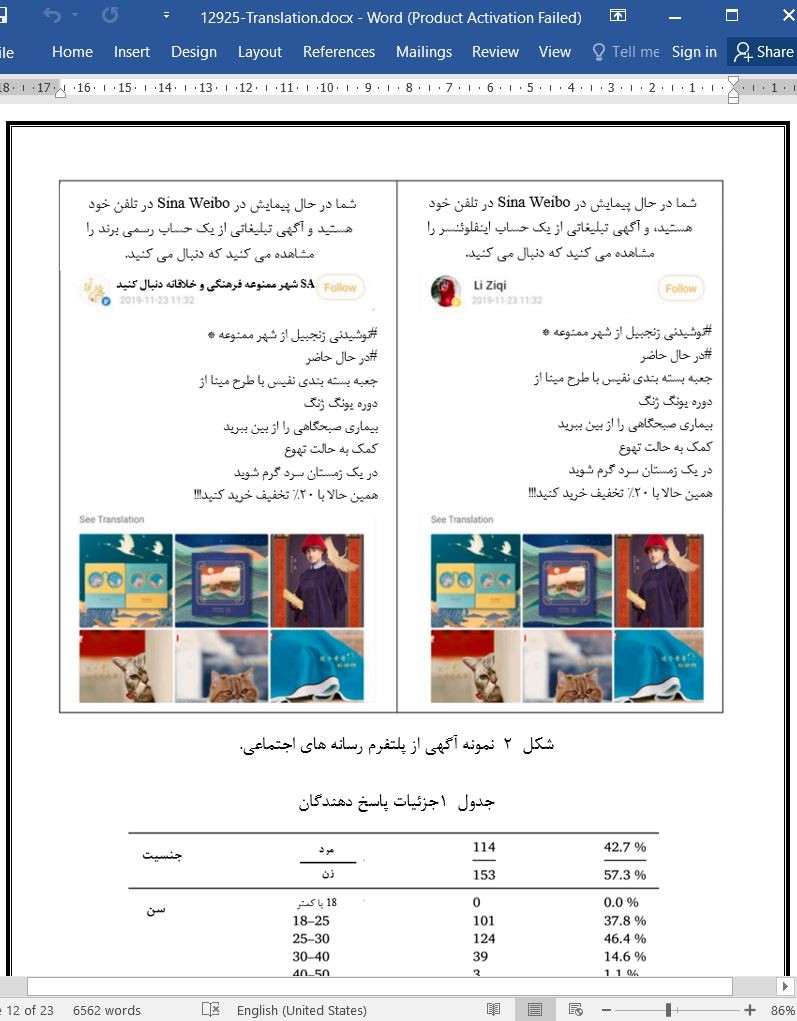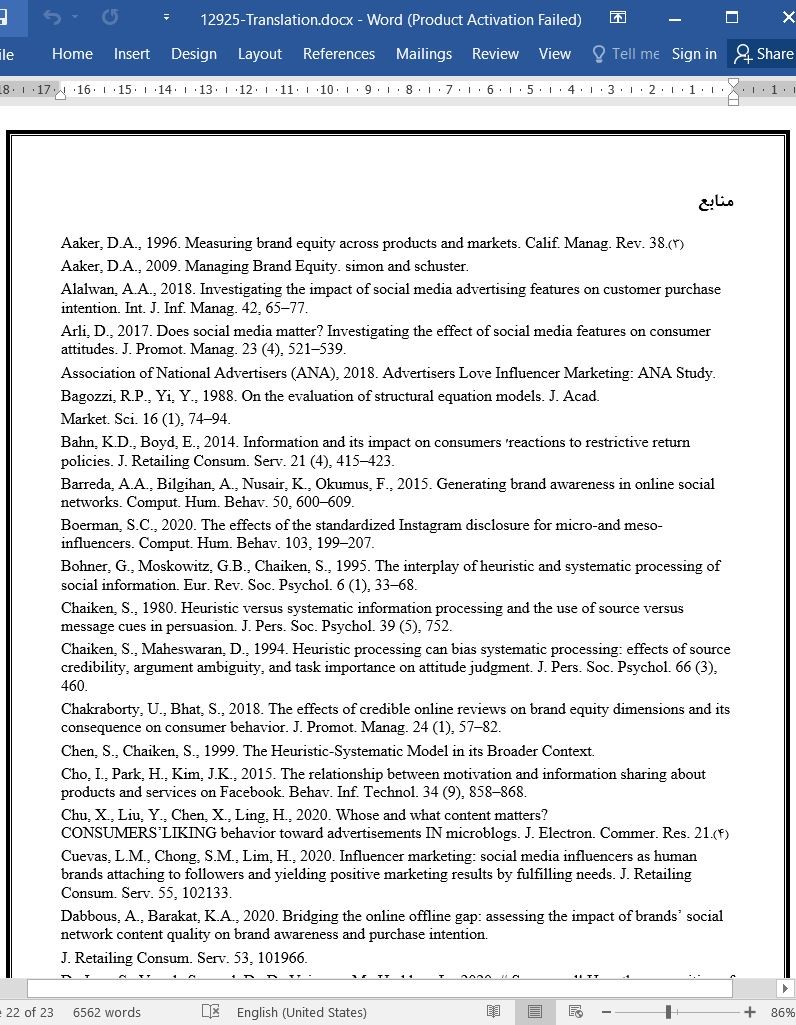
دانلود مقاله اثرات نشانه های هیوریستیک و سیستماتیک تبلیغاتی بر آگاهی از برند مصرف کننده و قصد خرید
چکیده
با افزایش تعداد کاربران دیجیتال ، تبلیغات رسانههای اجتماعی به یک کانال بازاریابی حیاتی برای جذب و حفظ مشتریان تبدیل میشود. با توجه به مدل هیوریستیک – سیستماتیک ، این تحقیق به بررسی اثرات نشانههای سیستماتیک تبلیغات شامل ارزشمندی تبلیغات و متقاعد کنندگی تبلیغات و نشانه هیوریستیک تبلیغات میپردازد که مقوله پوستر تبلیغات بر آگاهی از برند مصرفکننده و تاثیر متوالی بر قصد خرید مصرفکننده است. یک طرح آزمایشی با نمایش دو دسته از پوستر تبلیغاتی یعنی شرکت و اینفلوئنسر ، برای جمعآوری شواهد تجربی ایجاد شدهاست. نتایج نشان میدهد که ارزشمندی تبلیغات و متقاعد کنندگی به آگاهی بیشتر مصرفکننده از برند و قصد خرید کمک میکند. مقوله پوستر میتواند تاثیر ارزشمندی آگهی را به طور مثبت تحتتاثیر قرار دهد و پوستر شرکت زمانی که محتوای آگهی را کنترل میکند ، بهتر از پوستر تاثیرگذارتر عمل میکند. یافتهها وقوع همزمان پردازش اطلاعات هیوریستیک و سیستماتیک در زمینه تبلیغات رسانههای اجتماعی را نشان میدهد. این تحقیق درک فعلی تبلیغات رسانههای اجتماعی را عمیقتر میکند و مفاهیم عملی را برای بازاریابان فراهم میکند تا بر روی پوسترهای تبلیغاتی مختلف با توجه به ارزشمندی تبلیغات و ویژگی متقاعد کنندگی سرمایهگذاری کنند.
1 مقدمه
تبلیغات رسانههای اجتماعی با افزایش تعداد کاربران به سرعت در حال رشد است. این امر مزایای افزایش قرار گرفتن در معرض برند و ترافیک وب سایت را برای بازاریابان و صاحبان کسبوکار به ارمغان میآورد. (Stelz-ner, 2020) با این حال نحوه تعامل با مخاطبان هنوز هم سوال مهمی است که بازاریابان رسانههای اجتماعی با آن مواجه هستند. انتخاب تبلیغات موثر به دلیل پیچیدگی مکانیزم تاثیر گذار بر تبلیغات ، محدودیتهای بودجه و دیگر نگرانیهای برند برای بازاریابان چالش برانگیز است. با وجود این که عوامل مربوط به اثربخشی تبلیغات متنوع هستند ، طراحی محتوای تبلیغات و زمینه ارسال تبلیغات دو جنبه اصلی هستند که بازاریابان باید در نظر بگیرند.
ویژگیهای طراحی محتوای تبلیغات یعنی ارزشمندی اطلاعات ، احساسات ، تعامل به بازاریابان در ارائه اطلاعات محصول و ارزش برند به مشتریان کمک میکند بنابراین مشتریان را قادر میسازد تا براساس تفکر سیستماتیک خود تصمیمگیری کنند. تبلیغ اطلاعرسانی میتواند مسیر مصرف کنندگان را به سمت تغییر شکل و گسترش تبلیغات شفاهی هدایت کند و محتوای تبلیغاتی احساسی تمایل به تحریک همدلی مصرف کنندگان و افزایش تعامل آنها دارد. (Lee et al., 2018) تبلیغ تعاملی ممکن است مصرف کنندگان را سرگرم کند و قصد خرید آنها را افزایش دهد. (Alalwan, 2018) ویژگیهای متنی تبلیغات یعنی انواع پلتفرم ، محبوبیت پوستر ، فرآیند تصمیمگیری مصرفکننده را از طریق اثر سرریز تحتتاثیر قرار میدهند. (Voorveld et al., 2018; Boerman, 2020; Kim et al., 2019) یک پلتفرم رسانه اجتماعی با اعتماد مصرفکننده بالاتر ممکن است به قابلیت اعتماد تبلیغات پست شده روی پلتفرم کمک کند. (Geng et al., 2021) اینفلوئنسرهایی که تصویر عمومی قابل اعتمادی دارند ، ممکن است اعتبار درک شده آگهی را افزایش دهند. (Xiao et al., 2018)
8. جمعبندی
افزایش تعداد کاربران رسانههای اجتماعی تبلیغات رسانههای اجتماعی را به یک انتخاب بازاریابی مهم تبدیل کردهاست. با این حال چگونه مصرف کنندگان را درگیر کنیم و آگاهی از برند را ایجاد کنیم هنوز هم یک سوال چالش برانگیز برای بازاریابان میباشد. این مقاله برای به دست آوردن درک عمیقتر تاثیر گذار بر رفتار اجتماعی تبلیغات رسانههای اجتماعی ، این مسائل را به طور تجربی با تمایز بین دو حالت پردازش اطلاعات زمانی که مصرف کنندگان با نشانههای اطلاعاتی مختلف تبلیغات سر و کار دارند ، مورد بررسی قرار میدهد. یافتههای ما نشان میدهد که انتخاب پوستر شرکت زمانی مناسبتر است که طراحی محتوای آگهی به اندازه کافی آموزنده و متقاعد کننده باشد. عملکرد بازاریابی برتر اینفلوئنسرها زمانی رخ میدهد که محتوای تبلیغات با توجه به سبک اینفلوئنسرها مجددا طراحی و شخصی سازی شود. به طور کلی این یافتهها نشان میدهد که متخصصان باید ارزشمندی و متقاعد کنندگی محتوای آگهی را تضمین کنند و پوستر مناسب برای ارسال آگهی را انتخاب کنند.
Abstract
With growing numbers of digital users, social media advertising becomes a vital marketing channel for attracting and sustaining consumers. Drawing on the heuristic-systematic model, this research investigates the effects of advertisement systematic cues including ad informativeness and ad persuasiveness, and ad heuristic cue which is ad poster category on the consumer brand awareness, and the sequential effect on consumer purchase intention. An experimental design featuring two categories of ad poster, namely, firm and influencer, is created for empirical evidence collection. Results show that ad informativeness and ad persuasiveness contribute to greater consumer brand awareness and purchase intention. The poster category can positively bias the influence of ad informativeness, and firm poster outperforms the influencer poster when controlling the advertisement content the same. The findings demonstrate the co-occurrence of heuristic and systematic information processing in the social media advertising context. This research deepens current understanding of social media advertising and provides practical implications for marketers to capitalize on different ad posters according to advertisement informativeness and persuasiveness feature.
1. Introduction
Social media advertising is growing in leaps and bounds as the user number keeps increasing. This brings the benefits of increased brand exposure and website traffic for marketers and business owners (Stelzner, 2020). However, how to engage the audience is still the top question faced by social media marketers. Choosing effective advertising strategies is challenging for marketers due to the complexity of advertisement (ad) influencing mechanism, the budget constraints, and other brand concerns. Despite that factors related to ad effectiveness are diverse, ad content design and ad posting context are two central aspects that marketers need to consider.
Ad content design features, i.e. informativeness, emotion, interactivity, help marketers deliver product information and brand value to consumers, thus enable consumers to make decisions based on their systematic thinking. Informative ad can drive consumers’ path to conversion and spread the word of mouth, and emotional ad content tends to stimulate consumers’ empathy and enhance their engagement (Lee et al., 2018). Interactive ad might entertain consumers and increase their purchase intention (Alalwan, 2018). Ad contextual features, i.e. platform types, poster popularity, influence consumer decision making process through the spillover effect (Voorveld et al., 2018; Boerman, 2020; Kim et al., 2019). A social media platform with higher consumer trust may contribute to the trustworthiness of ads posted on the platform (Geng et al., 2021). Influencers with reliable public image may enhance the ad perceived credibility (Xiao et al., 2018).
8. Conclusion
The increasing amount of social media users makes social media advertising a critical marketing choice. However, how to engagement consumers and build brand awareness is still a challenging question for marketers. To obtain deeper understanding of the influencing mechanism of social media ads, this paper empirically explores these issues by distinguishing between two modes of information processing when consumers deal with different ad information cues. Our findings indicate that selecting firm poster is more appropriate when the ad content design is informative and persuasive enough. The superior marketing performance of influencer occurs when ad content is redesigned and personalized according to the influencer style. Overall, these findings suggest that practitioners should ensure the informativeness and persuasiveness of ad content, and select appropriate poster for ad posting.
H1. Social media ad posted by different ad poster has different influence on consumer brand awareness.
H2a. Ad informativeness positively affects brand awareness.
H2b. Ad persuasiveness positively affects brand awareness.
H3a. Ad poster category moderates the effect of ad informativeness on consumer brand awareness.
H3b. Ad poster category moderates the effect of ad persuasiveness on consumer brand awareness.
H4. Consumer brand awareness positively affects their purchase intention.
H5. Ad heuristic and systematic cues indirect influence the consumer purchase intention through the mediation of brand awareness.
H5a. Ad informativeness indirect influence the consumer purchase intention through the mediation of brand awareness.
H5b. Ad persuasiveness indirect influence the consumer purchase intention through the mediation of brand awareness.
H5c. Ad poster category indirect influence the consumer purchase intention through the mediation of brand awareness.
H1: تبلیغات رسانههای اجتماعی پست شده توسط پوستر تبلیغاتی مختلف ، تاثیر متفاوتی بر آگاهی مشتری از برند دارد.
H2a: ارزشمندی تبلیغات تاثیر مثبتی بر آگاهی از برند دارد.
H2b: متقاعد کنندگی تبلیغات تاثیر مثبتی بر آگاهی از برند دارد.
H3a: مقوله آگهی تبلیغاتی اثر ارزشمندی آگهی بر آگاهی مصرفکننده از برند را تعدیل میکند.
H3b: مقوله آگهی تبلیغاتی اثر متقاعد کنندگی آگهی تبلیغاتی بر آگاهی از برند مصرفکننده را تعدیل میکند.
H4: آگاهی از برند مصرفکننده به طور مثبت بر قصد خرید آنها تاثیر میگذارد.
H5: نشانههای هیوریستیک و سیستماتیک به طور غیر مستقیم قصد خرید مصرفکننده را از طریق میانجی گری آگاهی از برند تحتتاثیر قرار میدهند.
H5a: ارزشمندی تبلیغات به طور غیر مستقیم قصد خرید مصرفکننده را از طریق میانجی گری آگاهی از برند تحتتاثیر قرار میدهد.
H5b: متقاعد کنندگی تبلیغاتی به طور غیر مستقیم قصد خرید مصرفکننده را از طریق میانجی گری آگاهی از برند تحتتاثیر قرار میدهد.
H5c: مقوله پوستر تبلیغاتی به طور غیر مستقیم قصد خرید مصرفکننده را از طریق میانجی گری آگاهی از برند تحتتاثیر قرار میدهد.
چکیده
1 مقدمه
2. کار قبلی و توسعه فرضیهها
2.1 مدل هیوریستیک – سیستماتیک
2.2 توسعه فرضیهها
2.2.1 عامل هیوریستیک: مقوله پوستر
2.2.2 عوامل سیستماتیک: ارزشمندی تبلیغات و متقاعد کنندگی تبلیغات
2.2.3 اثر تعصب بین عوامل هیوریستیک و سیستماتیک
2.2.4 آگاهی از برند و قصد خرید
3. روش شناسی
3.1 طراحی تحقیق
3.2 مقیاس اندازهگیری
3.3 جمع اوری داده ها
4. تجزیه و تحلیل دادهها
4.1 تخمین مدل اندازهگیری
4.2 جهت گیری روش مشترک
5. نتایج
5.1 نتایج مدل ساختاری
5.1.1 تعدیل نتایج مدل
5.1.2 نتایج مدل تعدیل
6. بحث
6.1 بحث عمومی
6.2 مشارکتهای نظری
6.3 مفاهیم عملی
7. محدودیتها
8. جمعبندی
تقدیر و تشکر
ضمیمه A. داده تکمیلی
منابع
Abstract
1. Introduction
2. Prior work and hypotheses development
2.1. Heuristic-systematic model
2.2. Hypotheses development
2.2.1. Heuristic factor: poster category
2.2.2. Systematic factors: ad informativeness and ad persuasiveness
2.2.3. Bias effect between heuristic and systematic factors
2.2.4. Brand awareness and purchase intention
3. Methodology
3.1. Research design
3.2. Measurement scale
3.3. Data collection
4. Data analysis
4.1. Measurement model estimation
4.2. Common method bias
5. Results
5.1. Structural model results
5.1.1. Mediating model results
5.1.2. Moderating model results
6. Discussion
6.1. General discussion
6.2. Theoretical contributions
6.3. Practical implications
7. Limitations
8. Conclusion
Acknowledgement
Appendix A. Supplementary data
References
این محصول شامل پاورپوینت ترجمه نیز می باشد که پس از خرید قابل دانلود می باشد. پاورپوینت این مقاله حاوی 25 اسلاید و 6 فصل است. در صورت نیاز به ارائه مقاله در کنفرانس یا سمینار می توان از این فایل پاورپوینت استفاده کرد.
در این محصول، به همراه ترجمه کامل متن، یک فایل ورد ترجمه خلاصه نیز ارائه شده است. متن فارسی این مقاله در 9 صفحه (2070 کلمه) خلاصه شده و در داخل بسته قرار گرفته است.
علاوه بر ترجمه مقاله، یک فایل ورد نیز به این محصول اضافه شده است که در آن متن به صورت یک پاراگراف انگلیسی و یک پاراگراف فارسی درج شده است که باعث می شود به راحتی قادر به تشخیص ترجمه هر بخش از مقاله و مطالعه آن باشید. این فایل برای یادگیری و مطالعه همزمان متن انگلیسی و فارسی بسیار مفید می باشد.
بخش مهم دیگری از این محصول لغت نامه یا اصطلاحات تخصصی می باشد که در آن تعداد 45 عبارت و اصطلاح تخصصی استفاده شده در این مقاله در یک فایل اکسل جمع آوری شده است. در این فایل اصطلاحات انگلیسی (تک کلمه ای یا چند کلمه ای) در یک ستون و ترجمه آنها در ستون دیگر درج شده است که در صورت نیاز می توان به راحتی از این عبارات استفاده کرد.
- ترجمه فارسی مقاله با فرمت ورد (word) با قابلیت ویرایش و pdf بدون آرم سایت ای ترجمه
- پاورپوینت فارسی با فرمت pptx
- خلاصه فارسی با فرمت ورد (word)
- متن پاراگراف به پاراگراف انگلیسی و فارسی با فرمت ورد (word)
- اصطلاحات تخصصی با فرمت اکسل



